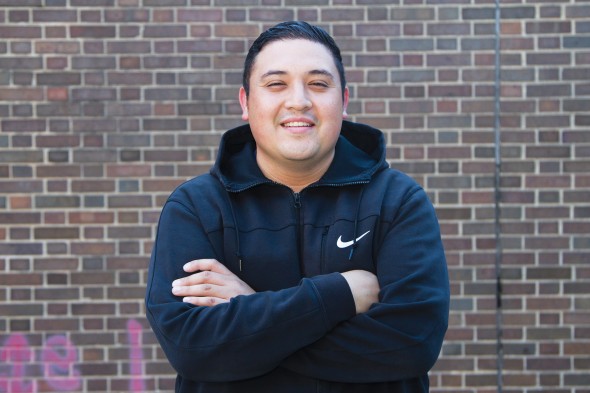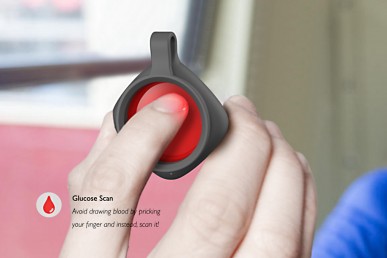East Meets West: Designing improved diabetes technology

“Physicians and faculty on the west side…helped give me the tools to make my idea a reality,” says Hector Silva. (Photo: Vibhu Sreevatsa Rangavasan)
After suffering the loss of his niece from a pregnancy complication, Hector Silva found solace in design.
During his research on gestational diabetes, Silva found the need for an inclusive product to improve the lives of millions living with all types of diabetes.
“I took this personal event and really wanted to do something to help — I didn’t know what or how,” said Silva, adjunct instructor in the School of Design and 2015 UIC graduate. “I ended up deciding to open up my idea to everyone affected by diabetes.”

Silva’s award-winning technology eliminates the discomfort of using a needle to check blood sugar levels. His wearable technology can also communicate with the user’s health care provider and notify emergency personnel if glucose levels are too low or high.
Silva began working on his master’s thesis project, spending two years researching diabetes and creating a form of wearable technology for people with diabetes. His outstanding work was awarded the Student Notable Consumer Product Award from Core77 Inc., an industrial design magazine.
He collaborated with diabetes experts at UIC, including Biobehavioral Health Science faculty members Cynthia Fritschi and Laurie Quinn.
“I met with physicians and faculty on the west side and they helped give me the tools to make my idea a reality,” he said.
His project, called Flore, provides an affordable, non-obtrusive way for people with diabetes to live a healthy lifestyle.
Flore would eliminate the discomfort of pricking the finger for glucose monitoring, using near infrared spectroscopy technology to scan the finger rather than drawing blood. The device also serves as a central location to track each activity involved in managing diabetes.
“I met with about 50 people who have diabetes and followed them around for the day, and the biggest problem that I saw was that they have to draw blood from their finger seven or eight times per day,” he said. “This device would avoid the pricking of the finger, let them know when it’s time to check their blood sugar or have a snack, and it monitors their exercise levels.”
The design would provide benefits to people who have disabilities, Fritschi said.
“His ideas to combine daily diabetes-related tasks with other health outcomes in one device would be a nice option for people with diabetes,” she said. “What’s especially hopeful is the needle-less blood glucose testing application.”
The wearable device would also have the capacity to communicate with the user’s health care provider, parents or spouses, sending data in real time. If blood glucose levels read as dangerously low or high, the device could notify emergency personnel.
Silva, who received his bachelor’s in industrial design from the Urbana-Champaign campus, would like to collaborate with a corporation to develop his product. He hopes his award-winning design will raise awareness about the struggle of managing diabetes.
“A lot of people don’t understand what it’s like to have diabetes,” he said. “I was ignorant about it and I would like to shed more light on the topic. I want to help people who have diabetes manage it and live a normal, healthy life without it taking over their entire life.”
